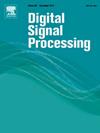Low-light image enhancement guided by multi-domain features for detail and texture enhancement
IF 2.9
3区 工程技术
Q2 ENGINEERING, ELECTRICAL & ELECTRONIC
引用次数: 0
Abstract
Low-light image enhancement holds significant value in the fields of computer vision and image processing, such as in applications like surveillance photography and medical imaging. Images captured in low-light environments typically suffer from significant noise levels, low contrast, and color distortion. Although existing low-light image enhancement techniques can improve image brightness and contrast to some extent, they often introduce noise or result in over-enhancement, leading to the loss of detail and texture. This paper introduces an innovative approach to low-light image enhancement by fusing spatial and frequency domain features while optimizing them with multiple loss functions. The core of the algorithm lies in its multi-branch feature extraction, multi-loss function constraints, and a carefully designed model structure. In particular, the model employs an encoder-decoder architecture, where the encoder extracts spatial features from the image, the Fourier feature extraction module captures frequency domain information, and the histogram feature encoder-decoder module processes global brightness distribution. These extracted features are then fused and reconstructed in the decoder to produce the enhanced image. In terms of loss functions, the algorithm combines perceptual loss, structural similarity loss, Fourier loss, and histogram loss to ensure comprehensive and natural enhancement effects. The novelty of this algorithm lies not only in its multi-branch feature extraction design but also in its unique model structure, which synergistically improves image quality across different domains, effectively preventing over-enhancement, and ultimately achieving a balanced enhancement of brightness, details, and texture. Experimental results on multiple datasets, including SIDD, LOL, MIT-Adobe-FiveK, and LOL-v2-synthetic, demonstrate that the proposed method outperforms existing techniques in terms of image detail, texture, and brightness. Specifically, it achieves a PSNR of 27.52 dB on the LOL dataset, surpassing Wavelet Diffusion by 1.19 dB. Additionally, on the LOL-v2-synthetic dataset, it achieves a PSNR of 29.56 dB, exceeding Wavelet Diffusion by 3.06 dB. These results demonstrate a significant enhancement in the visual quality of low-light images.
利用多域特征增强低照度图像的细节和纹理
弱光图像增强技术在计算机视觉和图像处理领域具有重要价值,例如在监控摄影和医疗成像等应用中。在低照度环境下拍摄的图像通常会出现明显的噪点、低对比度和色彩失真。虽然现有的低照度图像增强技术能在一定程度上提高图像亮度和对比度,但它们往往会引入噪点或导致过度增强,从而导致细节和纹理的丢失。本文介绍了一种创新的低照度图像增强方法,它融合了空间域和频域特征,同时利用多种损失函数对其进行优化。该算法的核心在于其多分支特征提取、多损失函数约束和精心设计的模型结构。特别是,该模型采用了编码器-解码器架构,其中编码器从图像中提取空间特征,傅立叶特征提取模块捕捉频域信息,直方图特征编码器-解码器模块处理全局亮度分布。然后在解码器中融合和重建这些提取的特征,生成增强图像。在损失函数方面,该算法结合了感知损失、结构相似性损失、傅里叶损失和直方图损失,以确保全面而自然的增强效果。该算法的新颖之处不仅在于其多分支特征提取设计,还在于其独特的模型结构,能协同改善不同领域的图像质量,有效防止过度增强,最终实现亮度、细节和纹理的均衡增强。在 SIDD、LOL、MIT-Adobe-FiveK 和 LOL-v2-synthetic 等多个数据集上的实验结果表明,所提出的方法在图像细节、纹理和亮度方面都优于现有技术。具体来说,它在 LOL 数据集上的 PSNR 达到 27.52 dB,比小波扩散技术高出 1.19 dB。此外,在 LOL-v2 合成数据集上,它的 PSNR 达到 29.56 dB,比小波扩散高出 3.06 dB。这些结果表明,小波扩散技术显著提高了低照度图像的视觉质量。
本文章由计算机程序翻译,如有差异,请以英文原文为准。
求助全文
约1分钟内获得全文
求助全文
来源期刊

Digital Signal Processing
工程技术-工程:电子与电气
CiteScore
5.30
自引率
17.20%
发文量
435
审稿时长
66 days
期刊介绍:
Digital Signal Processing: A Review Journal is one of the oldest and most established journals in the field of signal processing yet it aims to be the most innovative. The Journal invites top quality research articles at the frontiers of research in all aspects of signal processing. Our objective is to provide a platform for the publication of ground-breaking research in signal processing with both academic and industrial appeal.
The journal has a special emphasis on statistical signal processing methodology such as Bayesian signal processing, and encourages articles on emerging applications of signal processing such as:
• big data• machine learning• internet of things• information security• systems biology and computational biology,• financial time series analysis,• autonomous vehicles,• quantum computing,• neuromorphic engineering,• human-computer interaction and intelligent user interfaces,• environmental signal processing,• geophysical signal processing including seismic signal processing,• chemioinformatics and bioinformatics,• audio, visual and performance arts,• disaster management and prevention,• renewable energy,
 求助内容:
求助内容: 应助结果提醒方式:
应助结果提醒方式:


